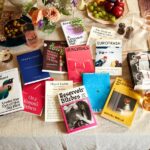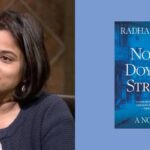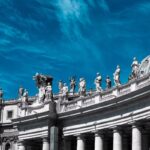Professors, Priests, Provosts, Manholes, and More: 7 Poetry Books to Read This May
Rebecca Morgan Frank Recommends Catherine Barnett, Jeremy Michael Clark, Ann Jäderlund, and More
This stack of May books reminds me of why I love the lyric poem, its flexibilities of tone, of voice, of movement, how much it allows for, even in the smallest of spaces, be it line or poem. Among this batch of poets you’ll find an Episcopal priest; a librarian-turned-professor; a provost at a Christian college; and a celebrated Swedish poet and playwright whose concise poems make her a perfect Brunnslock poet, or “manhole poet,” her poems cast on manhole covers through an award-based Swedish public poetry initiative.
From the minimalism of Ann Jäderlund to the maximalist sensibility of Karen An-hwei Lee, and through the archival roots of collections by Alison Rollins and Michael Goodfellow, this month’s line-up circles around perspective and framing. And light. I keep returning to this image from Goodfellow’s “Lullaby”: “When night was a setting/ you held in your hands, / stars carved /in a tin can/ lit with a flicked match.”
*

Catherine Barnett, Solutions for the Problem of Bodies in Space
“Why do you think they like to be together?” The “they” here: birds. There is a devastating down-to-earth marriage of wit and elegy in Barnett’s transcendent fourth collection, which opens in childhood—”I understood I was alone, or wanted to be alone”—in the first of ten “Studies in Loneliness,” the last of which begins at the bedside of the poet’s close friend and colleague, Saskia Hamilton. “Around him we were // a collective / for which there existed no name,” she says of her father’s death, and “[t]he body is a big dumb object, he taught us. / Death is a genius.”
The living who populate these poems include figures such as Nicholson Baker, “with whom I might have fallen in love / were he not married and living in Maine,” and who the speaker instead walks through Times Square as his pants fall down; and Ememem, the Parisian “poet of asphalt,” who “wherever the city is breaking apart,” “[r]eplaces the missing pieces—/ the cracks, potholes—” in the night.
In “Envoy,” the speaker at first tries “to look a little less like myself, and more like other humans” by donning a skort, but by the end is burying an imperial moth she has watched closely; there in the detritus: “she glowed a little.”

Jeremy Michael Clark, The Trouble with Light
“The water/ seeped through a window & I felt // so confused. How like a child, / to think the house has started to cry.” Clark’s collection, selected by series editor Patricia Smith as a finalist for the Miller Williams Poetry Prize, holds at its center childhood trauma tied to an absent father and abusive stepfather. Marked scenes of violence and fear pulse amidst poems of the impacts of silences broken—”How easily they slap / a label on a mouth”—or kept; one poem is titled “One Year Sober.”
In the first of two poems titled “In the Hometown I’ve Tried to Love,” the speaker wonders, “I don’t know which I’d rather be: / the one who stayed, or the one who walked away,” while “State of Denial” encompasses the broader inheritances of violence of the poet’s home state of Kentucky: “as though dread isn’t what sways the trees, / as though one could turn away from that, // as though this wasn’t the enslaved side of the river.”
Toward the end of the collection Clark’s cento, “Unauthorized Biography,” comes as a gateway, a breath of survival, one that begins with Solomon Burke’s “Down in the Valley” and ends with Janelle Monáe’s “Dance or Die.”
Michael Goodfellow, Folklore of Lunenburg County
“Water had been ghost, land its corpse. | You didn’t die, you were held up to drown. | Patterns in the hay on the barn floor suggest which spouse will die first.” “Motifs,” a series of segmented prose poems threaded amidst Michael Goodfellow’s painterly lyrics, forefronts the collection’s range of collecting, from lore to tools: “hawser, shucking knife, dead eye, door jig, rockweed hoe….”
Rooted in the particularities of a place and its survival, the arresting and evocative color palate in these poems conjures up qualities of light and water—”the way a bottle caught the lawn’s green, // an old mirror, its silver peeled off, // slush of a half frozen pond, / light sharded and bubbled with sedge”—including shifting confluences of sea and sky, as the sun “glittered, wet with salt” and “hung in the sky, kelpy and dripping burnished.” Here, the wind is “the quiet of blown glass.”
Supernatural inheritances hover as ghost tales embedded in earthly scraping of survival into story. Looking into a dry well, “You called the traces of damp a constellation. / You made up stories for what we were.” How fitting that the gorgeously made Folklore of Lunenburg County, which draws on Canadian ethnographer Helen Creighton’s collections of folk songs and stories, comes from Gaspereau Press’s own printing works in Nova Scotia.

Ann Jäderlund, Lonespeech (trans. Johannes Göransson)
“It burns / today can / you answer”—that’s half of a poem by Swedish poet and playwright Ann Jäderlund, who has also translated Emily Dickinson into Swedish. Built from language collaged from translations of correspondence between Paul Celan and Ingeborg Bachmann, these poems may be Instagram-ready in size, but Jäderlund can deliver a compelling torquing of vision and voice.
Amidst tautological disruptions of the epigrammatic, syntax edges, eyes stare out: “All have needs / needs in their eyes / fists”; and synesthesia flourishes: “Forest black / all clang” and “We scoop the sounds / scoop and moan.” Extracted from the whole, individual poems, in English at least, might strike some as uneven in their hefts of strangeness and trafficking of sparse simplicity, but there is something compelling and fresh about the collective sweep and leaps of Jäderlund’s peculiar concisions in the hands of translator Johannes Göransson, who persuasively turns to Anne Carson’s notion of “catastrophizing” in his notes.

Karen An-hwei Lee, The Beautiful Immunity
In “On Hierophany,” the speaker of Lee’s The Beautiful Immunity attempts to plumb the linguistic and bodily poetic reaches of “the sacred and profane”: “I dare you to use the word / hernia in a poem, said a friend. So I not only used / the word, I invited God into language.”
Lee mines varied textures and tones of the material world in scope and vocabulary, linking prayer, machine (including the machine of time), and the natural world–these poems are lush with “engines of scent” and flowers; “[r]ains revived the sea lettuce and sea fig, bougainvillea, chapparal/ understory” in the opening poem “In the Millennial Year of the Superbloom,” and flowers keep coming. These are poems of telescope and microscope; of prayer in the vein of “Prayer for a Box of Lightning” and “Blessing for the Lentils;” and of meditation, such as in “On Apophasis and the Unnamable” and “On the Levitation of Beautiful Objects.”
There’s a maximalist eclecticism in Lee’s scope and imagery. The best moments find focus: “We conjure bees / drawing water in their bellies, glass bulbs of rain // flying over culverts and arroyos in search of hovels / to call home.”

Spencer Reece, Acts
“Painting is the kinder art,” concludes Spencer Reece’s “In Solitaria Stanza.” The speaker’s mother has dementia, and in the poem portrait, he “Wipes her red bottom. / Cuts up her skirt steak. / She weeps. She yells.” To love and/or to serve includes a bodily record of care in these poems; for the Bishop, the speaker “places three sets of drops / into the jelly of the bad eye” and “rotate[s] around / the glaucous unworkable dead orb like a clock. / Keeping his confidences.”
Reece, an Episcopal priest, allows us behind the alter with no fanfare, but with the formal flare of a virtuoso. We follow him on a trip to “consecrate a peluquería” (hairdresser); learn of his errors in the church newsletter to the time he “forgot everything and stalled at the altar,” but nothing is ever dull in its recounting. “What do I know?” the speaker asks, amidst “people who died for their faith”; elsewhere, he eyes “this city of dead Empire.”
A stunning poem in the voice of Maria Magdelena offers a fierce portrayal of mockery for faithful; she’s called a bitch, she’s laughed at, but “I no longer cared. // “When my nailed human was free, / I left.”

Alison C. Rollins, Black Bell
“Can’t you tell? Mouthpiece / from lips, flesh from wood.” So concludes “A Child is Like a Clarinet,” one of the pointed touchstones of Alison C. Rollin’s expansive Black Bell; the poem begins, “Similes are dangerous.” Rollins interrogations range beyond the linguistic, however. “Black Bell,” which echoes across a series of titular poems, engages with a drawing captioned “A woman with iron horn and bells on, to keep her from running away,” but reframed by Rollins with the title “The Art of Dancing Explained by Reading Female Figures.”
Other reframed, annotated and repurposed materials include hymn lyrics and a guide of song-birds, and Rollins brings performance notes to a few poems, including “Phillis Wheatley Takes Turing Test,” in which the interrogator is directed to be “computer-generated or synthetic voice,” while Wheatley is to be “read aloud by a human.”
Amidst these ranging hybrid interventions, the lyric poems offer tight punches: “Nine Circles of Hell (36 Chambers)” includes the poems Limbo, Gluttony, Greed, Anger, Heresy, Violence, Fraud and Treachery, as well as “Lust”: “every sin I have / committed has been an act of / self-love, I did what any man / in my own shoes would do.” In the final Black Bell poem, the penultimate lines reverberate: “Inside the wall of her cheek / was a sliver of violence / only she could trust.”




















